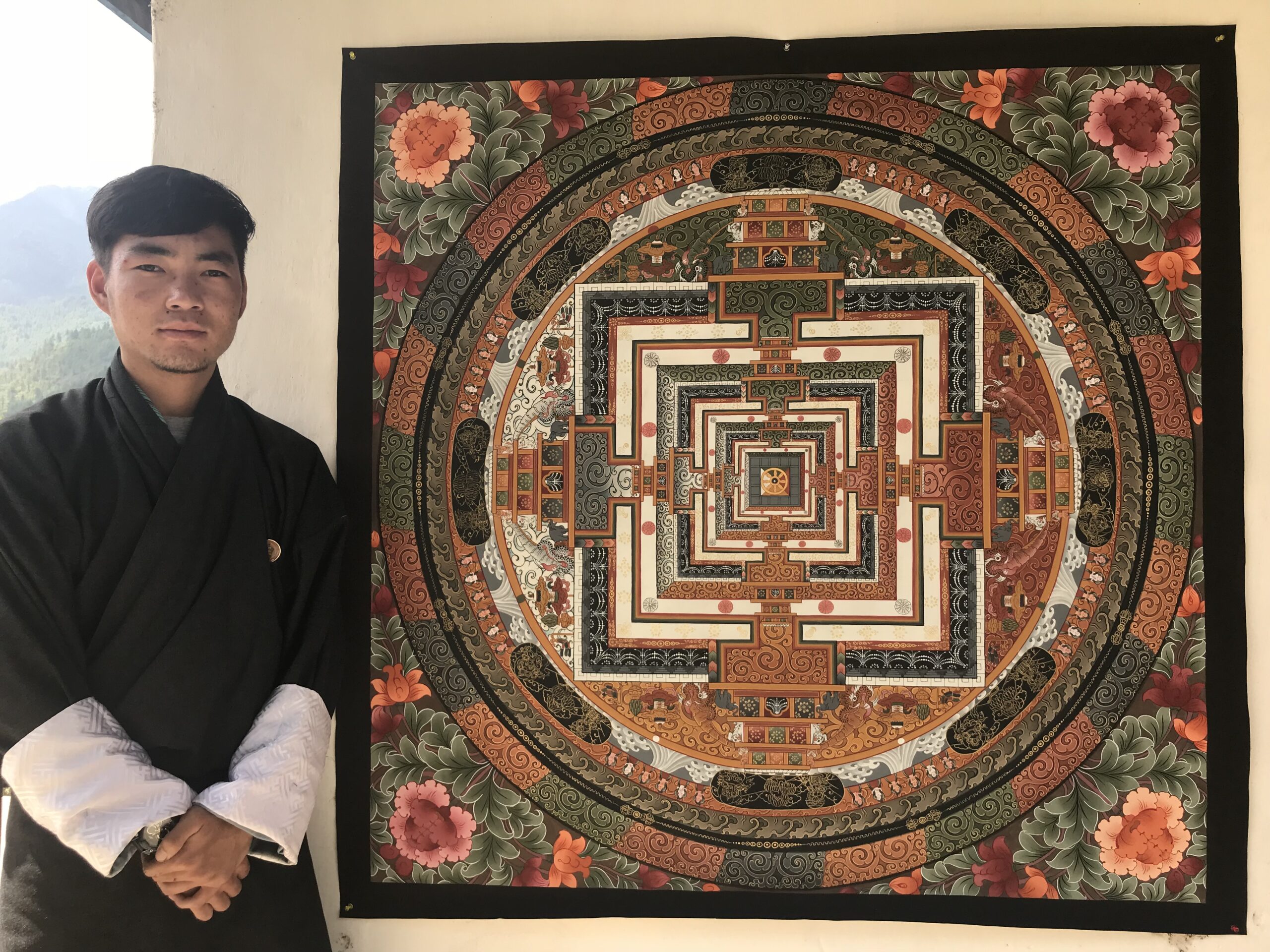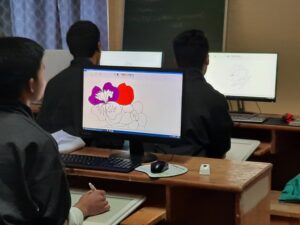


Lhadi, the art of painting gods and myths, is an essential part of Bhutan’s cultural heritage and religion and is one of the Zorig Chusum (13 traditional arts and crafts). Lhadi has been and still plays a crucial role in preserving the spirituality, the sacred beliefs intertwined with Bhutanese culture and mythology, and keeps alive the spiritual heritage that has been passed down since the beginning. Lhadi creates works of art that becomes objects of immense belief and worship and immortalizes the myths behind it.
There are two distinctions of Lhadi which are based on the medium that is being painted on: shingtshoen (wood paint) and Thangka (painting on canvas). There are also two main skills in Lhadi: the art of drawing rimo (traditional sketches to be painted) and the art of painting.

Lhadi Level One students learn to draw simple drawings of symbols like patra zheten rimo, luroe (dangpa, ngepa & sumpa), goendriem, choezay rimo and tashi dagay (the Eight Lucky Signs).
Lhadi Level One are taught how to mix basic colors using sa tshoen (mud paint), zang tshoen (copper paint) and waterproof paint. They are also taught how to do simple paintings of symbols and flowers like sew meto pem, kaba meto, norbu gongkhay and ting (clouds). Students also get to try painting rabsey (traditional Bhutanese house painting design) like kaba, tenkhep, ngap, tenkha, janachari on canvas.
Lhadi Level Two students move on to learn drawing difficult drawings of Zhugngyen (living creatures) like the Lokhor chuni (12 zodiac animals), the four auspicious animals (the tiger, snow lion, garuda and dragon) and the Thuenpapunzhi (the Four Harmonious Friends). They also learn difficult drawings such as tashi zagay (melong, zho, yungkar, tshadurwa, loethrie, giwang, shingthog belwa and dungkar).
Lhadi Level Two students are taught how to make canvas on rashey (wooden frame) and paint wood carvings depicting the dragon, tashi dagay, the four auspicious animals and also paint them on the canvas.
Lhadi Level Three students are taught to draw the Gyeltshen ngaduen (Seven Precious Possession of the Chakravartin) and the features of the Buddha (face, hand and legs with precision).
Lhadi Level Three students are taught to paint the Four Auspicious Animals; on carvings and on canvas, and the Lungta deanga (wind horse), Thuenpapunzhi (Four Harmonious Friends) and Tshering namdru on canvas and furniture.
Lhadi Level Four students learn to draw physical features of the Tara face, hand and leg) and, the face and limbs of the Vajarapani (Chana Dorji).
Lhadi Level Four students learn to paint tshering namdru, toenpa kuchang (Buddha), toenpa menlha kuchang (Medicine Buddha), jampelyang kuchang (Manjushree, the wisdom god), and the Green Tara kuchang.
Lhadi Level Five students are taught to draw Guru cherbu with namzha chatshang, Dorji Pham cherbu with namzha chachang (Vajararahi), Jangsem cherbu with namzha chachang, and Namsay cherbu (god of wealth) with namzha chatshang.
Lhadi Level Five students are taught to paint the White Tara kuchang, Chenrigzhi kuchang (Avalokistiherva), large scale Kilkhor mandala, Guru kuchang, and large scale Toenpa Tshokhor sum (Buddha with his two disciples).
Lhadi Level Six students learn to draw the Phub cherbu with namzha chatsang, Dechog cherbu with namzha chachang, and the face of the Chatong chentong (Avalokiteshvara with a thousand eyes and arms), cherbu with namzha chachang.
Lhadi Level Six students learn to paint the large scale Namsay kuchang (god of wealth), Chana Dorji (Vajarpani), Zhabdrung tshokhor sum, guru tshokhor sum (Guru Rinpoche with his two concerts), rigsum goem and tsheylham namsum.

Lhadi Level Seven is considered as a professional program because it is a transitional period from school to the real world. Students are introduced to the job market by school alumni and get advice from alumnus who have already gained significant knowledge about doing Lhadi in the real world.
Lhadi students are required to complete six-ten weeks of On the Job Training (OJT), a period of internship that offers students practical experience.
In order to get promoted to next level, students are assessed on a monthly basis and have to clear the exam. Students are expected to take exams twice a year, in July and in December. By the end of the year, the students are expected to draw rimo accurately from memory, make their own blue print designs, understand the sequence of painting and paint as per the requirements.
By the end of the year, students are expected to have mastered drawing rimo and painting and have full understanding with its meaning and significance. In order to get the degree certificate the student are assessed on the hardship basis of their work and have to clear the exam successfully.

Students learn basic computer skills such as typing, creating slides, using the internet as a resource and basic graphic design. The program was introduced in 2012 with the objective to provide basic IT knowledge.

Students learn simple Dzongkha with the basic skills of reading and writing in Dzongkha. Since Dzongkha is a key aspect of our culture, students are taught Dzongkha to enrich their craft and learning experience.

Students learn simple English with the basic skills of reading, writing, listening and speaking in English. They learn to comprehend simple texts and hold conversations in english.

Students learn simple math skills like adding, subtracting, multiplying and dividing numbers to solve problems. They also learn basic formulas and equations.
To provide students with the opportunity to explore various crafts and discover their individual inclinations, enabling them to make informed decisions about their chosen field of study, the school has introduced foundation classes in three new crafts starting 2025.
This initiative not only allows students to gain hands-on experience in different artistic disciplines but also provides an opportunity for those who did not qualify in the selection interview to develop their skills. Based on their performance, they may be enrolled in their chosen program the following year, ensuring that passionate learners get the chance to pursue their artistic aspirations.




© Choki Traditional Art School. All rights reserved 2021